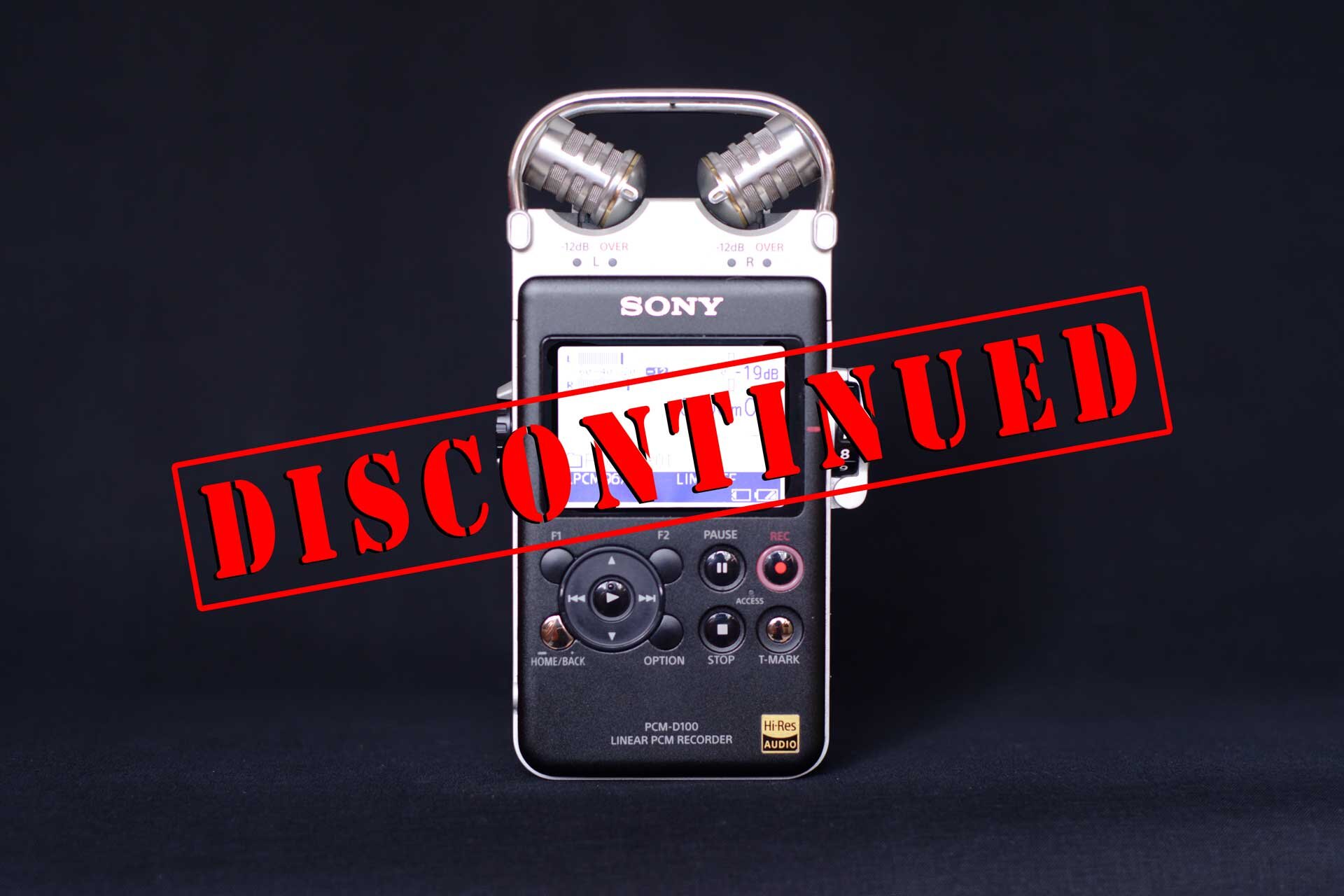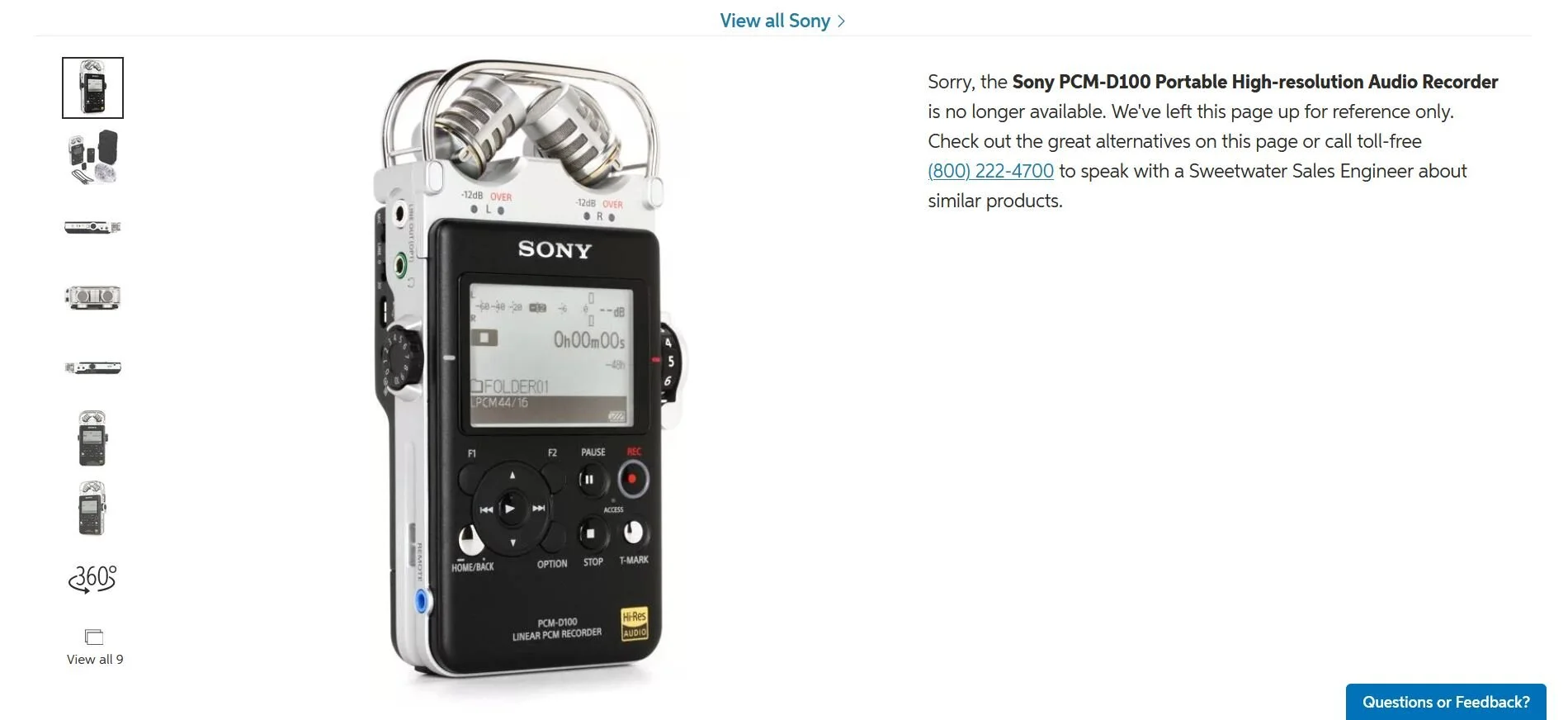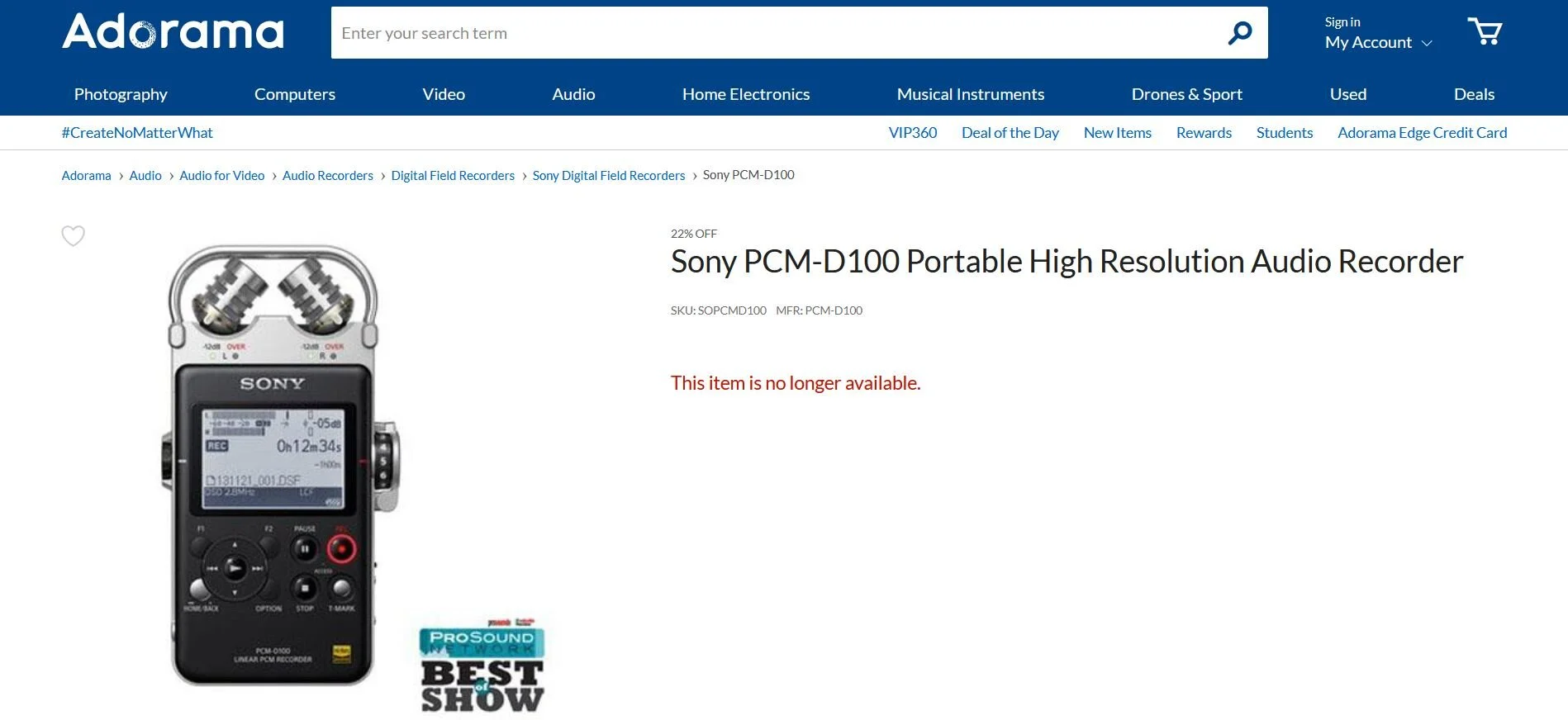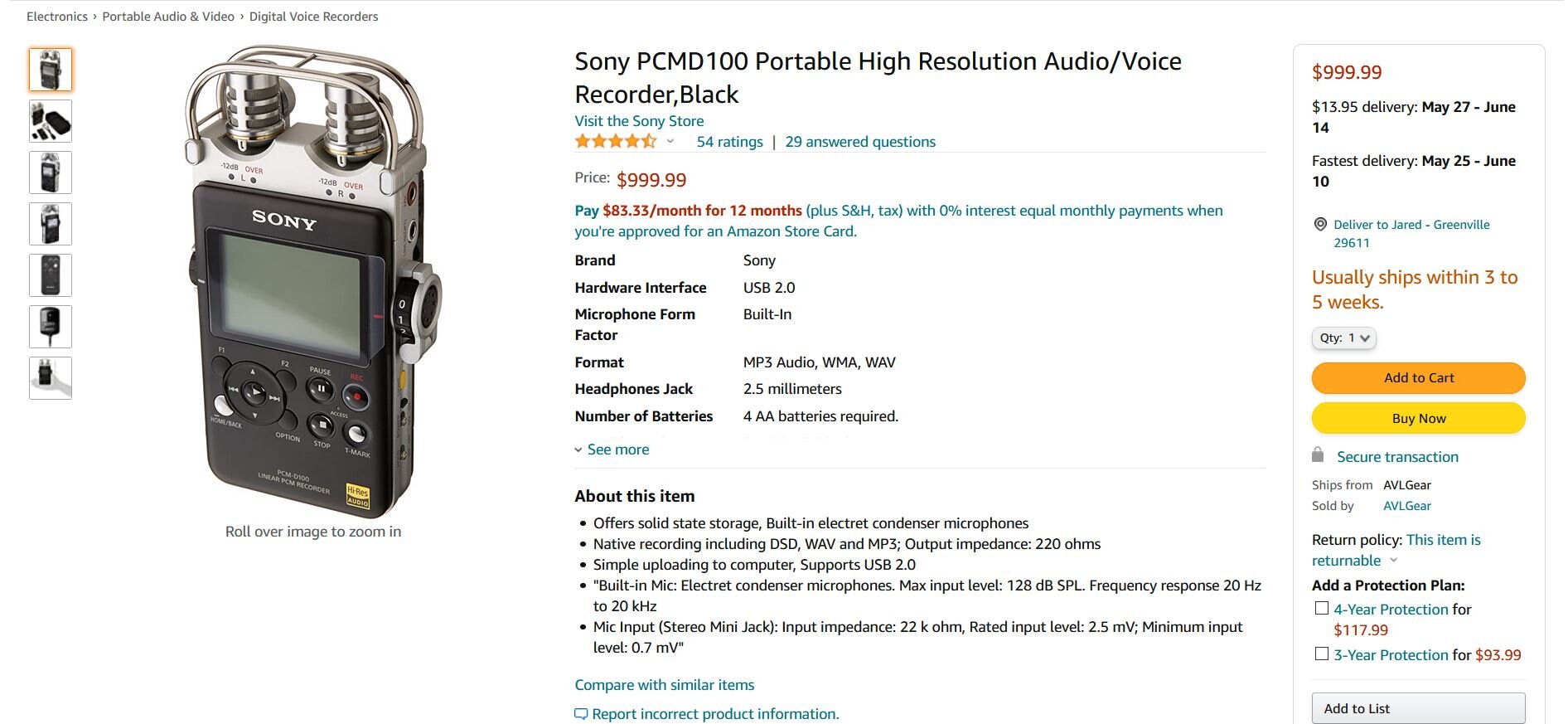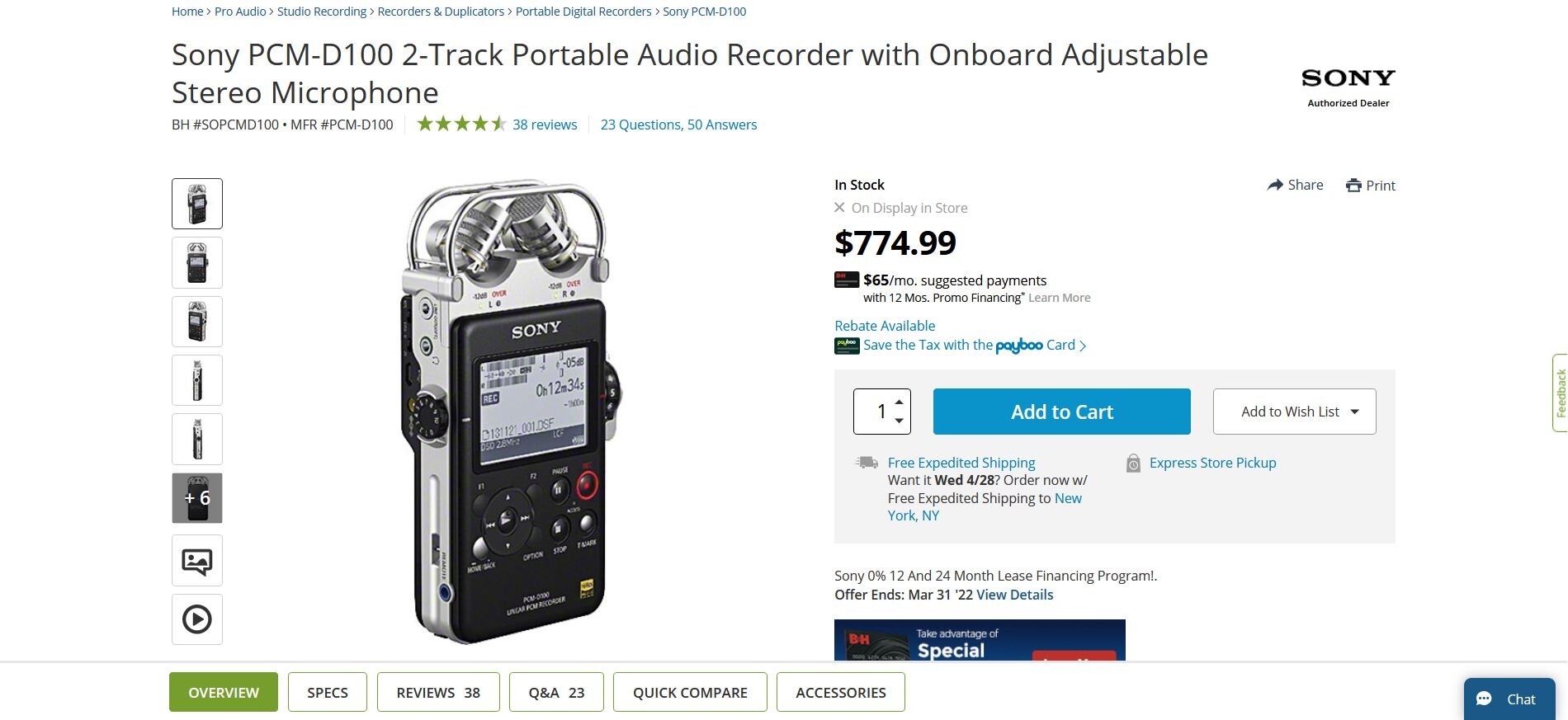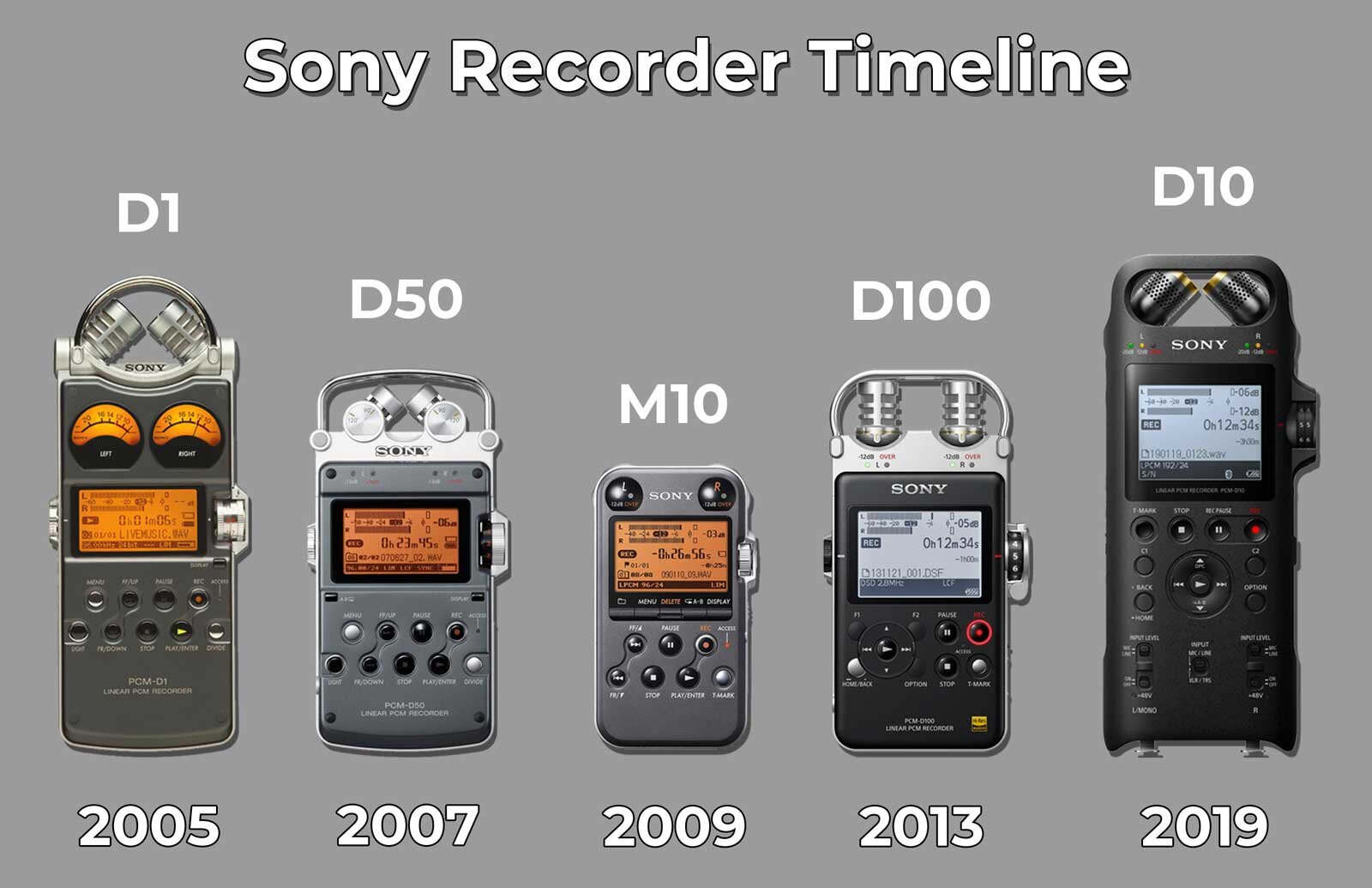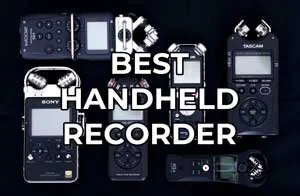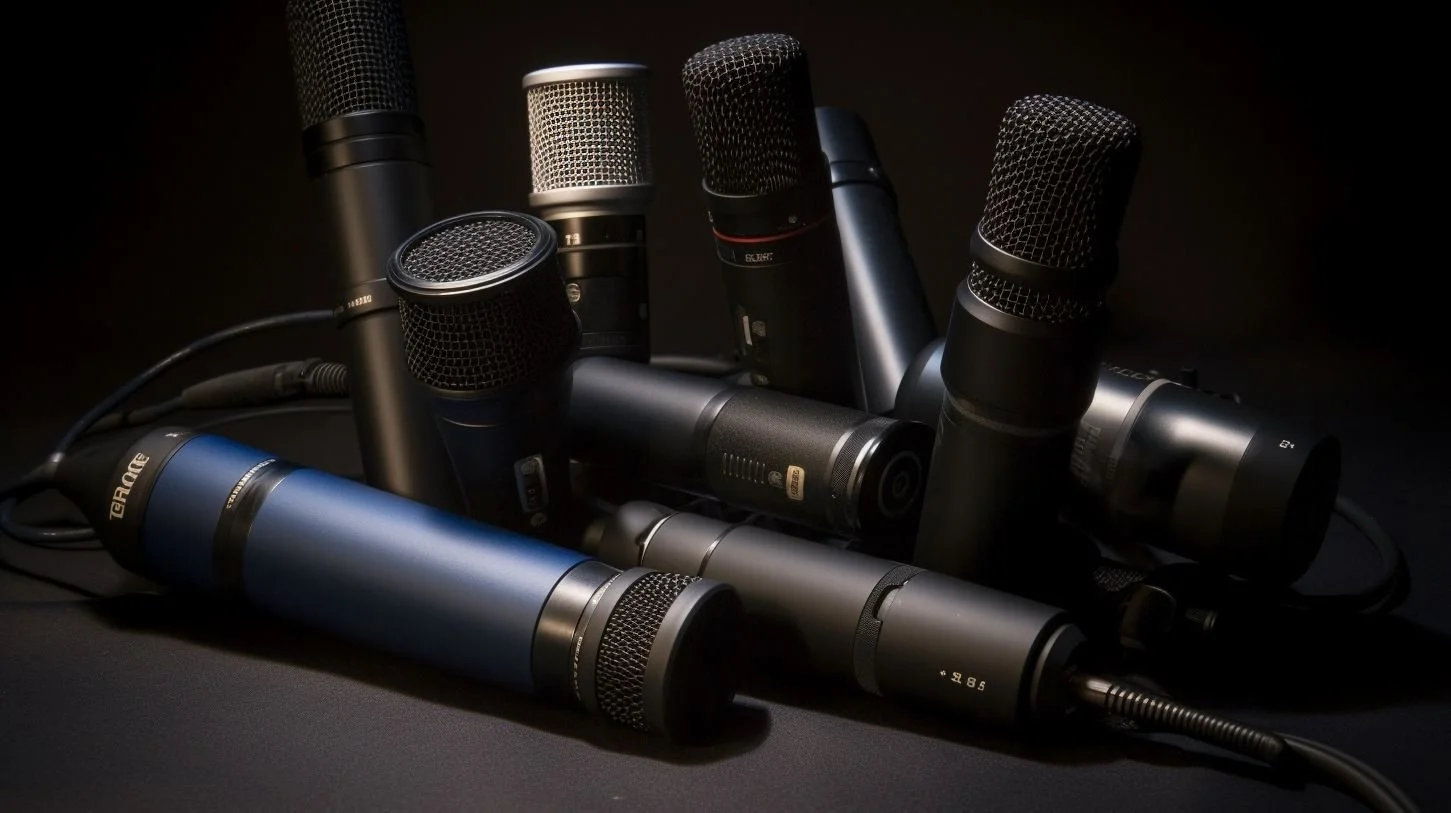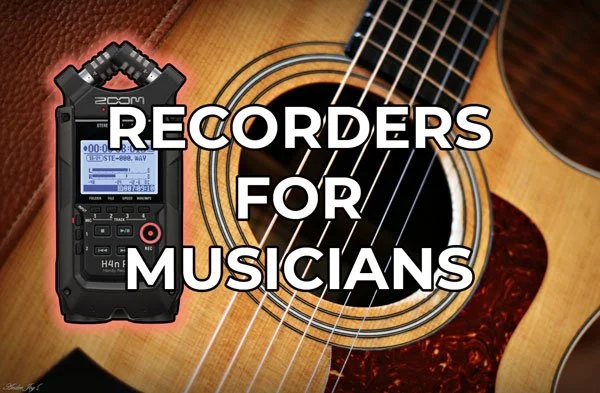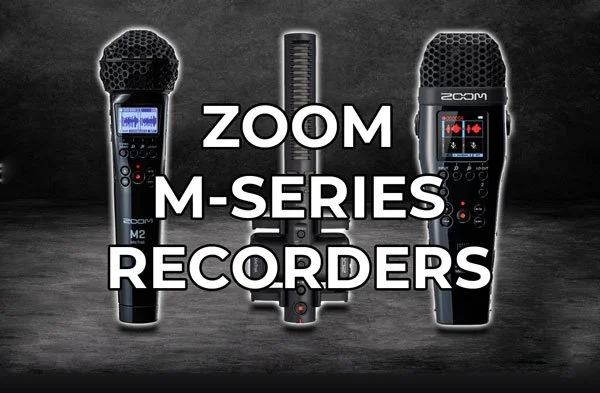Sony PCM D100 Discontinued: Are Field Recorders Getting Worse?
With the D-100 set to be discontinued world-wide, are field recorders getting worse?
As of March 15th, 2021, Sony has discontinued the PCM D-100 in the United States and will discontinue the field recorder world-wide. There are officially a finite number of these recorders out there and they are becoming increasingly difficult to find.
Click here to check availability on eBay.
The PCM D-100 still reigns as the best handheld field recorder, so this news comes as a shock. However, this is not the first time a manufacturer has discontinued a superior field recorder without an equivalent replacement.
So, the question is, why are field recorders getting worse? This article will examine field recorder releases from multiple manufactures and try to understand why this unfortunate trend continues.
Table of Contents:
• Is It Really Discontinued? • Why Was The D100 So Good? • What Is The D100 Successor? • Are Field Recorders Getting Worse? • The Best New Field Recorder
Links in this article are affiliate including Amazon Associates. Purchasing through these links will earn me a small commission at no extra cost to you. Thank you for your support!
Is It Really Discontinued?
Email confirmation from Sony stating that the Sony PCM D-100 has already been discontinued in the US.
After multiple phone calls and emails to Sony and retailers, I was finally able to get a definitive answer. The Sony PCM D-100 has been discontinued in the United States as of 3/15/2021 and will be discontinued world-wide.
My Detective Work:
Without any official statement or removal of the D100 from the Pro.Sony.com website, it is difficult to say for sure if the D100 has actually been discontinued.
I tried to get a definitive answer on this from Sony but hit a dead end. I contacted Sony Professional and was told that because the D100 still appears on this page, the recorder has not been discontinued by Sony. The only other recorders listed there are the A10 and the D10 which both came out recently in 2019.
When I pressed for a more definitive answer from the Sony rep, I was informed that only sales would have the information necessary to answer my question. So, naturally I asked to be connected with the sales department but was told that only individuals from authorized retailers could speak with sales. Dead end.
Next, I contacted B&H Photo and Adorama. B&H Photo listed the D100 as “discontinued” last week but recently got 10 more units in stock. They were unable to tell me if they were getting more.
Adorama is currently out of stock and say that the D100 is “no longer available” and lists alternative products. The representative I spoke with said that they had an order for more from their supplier and that the supplier marked the order as discontinued.
I did not contact Sweetwater, but they also list the D100 as “no longer available” on their site.
What I found odd about all these retailers’ websites is that they all indicate, or have indicated, that the D100 is discontinued, not “out of stock,” or “more on the way,” like is normal when inventory temporarily reaches zero.
Still not satisfied, I decided to email Sony Pro Support. After hearing that only Sony Sales Representatives could answer my question, I asked to be connected with a sales rep. They couldn’t connect me directly, but said that they would “ask our support team if Sony already stopped manufacturing this unit.”
One day later, I received the email confirming the D-100’s fate.
Why Was The D-100 So Good?
Before we can fully understand why the PCM D-100 is such a good field recorder, we must first learn some basic terms.
When I judge how good or bad a field recorder is, I am only concerned with how well the device records sound. After all, that is the primary purpose of a field recorder.
The determining factor of sound quality is noise. Noise is the unwanted hissing sound that you may hear in the background of some of your recordings. It is not a natural sound from the surrounding environment, but is added to the final recording and can be heard during playback.
The amount of noise a field recorder produces depends on the quality of the internal microphones and the design and components of the preamplifier, which provides power to the microphones.
The amount of noise you hear in the final recording depends on the signal-to-noise ratio (SNR). The signal is the sound of what you are trying to record. Noise is what we just covered; the amount of hissing sound produced by the recorder itself.
If your signal is very loud, you likely won’t hear any hiss because the recorder’s noise is overpowered by the signal. If you are recording your voice by speaking directly into your device’s microphones, your voice might be 10-times louder than the recorder’s noise. In this case, your SNR would be 10:1.
However, if you signal is quiet, like a chirping bird, it might be the same volume as the recorder’s noise, giving you an SNR of 1:1. In this case, the noise of the recorder is equal in loudness to that of your signal and will be very distracting in the final recording.
Since almost any recorder can achieve a hiss-free recording of loud signals, I judge field recorders by how well they can record quiet signals.
In my opinion, “good” field recorders add very little noise to the final recording, and “bad” recorders add so much noise, that the hissing sound becomes distracting to the listener.
The Sony PCM D-100 is an amazing recorder because it has the lowest amount of noise of any handheld on the market. The noise of the D-100 has been measured at -127 dBU, which is comparable to dedicated recorders from Sound Devices that cost over one thousand dollars.
Sony PCM D-100 Successor?
With the king of handhelds dethroned, who will take its place?
The current flagship model from Sony is the PCM D-10. Unfortunately, it has much more noise than the D-100, and isn’t even second-best on the handheld market.
Currently, the Tascam DR-100 mkiii is the quietest on the market with a self-noise of -126 dBU. This is just -1 dBU behind the D100 and the Tascam also has 2 XLR inputs. The Tascam DR-100 mkiii is also much more affordable than the D-100.
If you are not satisfied with this compromise, the Sony D-100 will still be available second-hand on eBay.
Personally, I’m hoping that Sony will replace the D-100 with an improved model, but I don’t think this is realistic.
With the release of the D-100 in 2013, and the D-10 in 2019, it’s unlikely that Sony will release a new flagship recorder anytime soon.
Are Field Recorders Getting Worse?
With the D-100 discontinued, the flagship Sony model is now the Sony PCM D-10. Since the D-10 is not comparable to the D-100 in terms of noise, this is a step backwards in sound quality and marks an unfortunate trend in the field recorder industry.
In this section we’ll look at product timelines from two of the most beloved and sought after field recorder manufactures: Sony and Olympus.
Sony Product History
Sony has a history of being one of the best manufactures of handheld field recorders. Since the release of the PCM-D1 back in 2005, they have been industry leaders in the field.
To this day, the D50 and M10 models are highly sought after on the used marketplace, and I believe we can expect the same of the D100.
Using the data from Avisoft’s field recorder tests, lets see how these recorders compare in terms of self-noise. Avisoft has independently tested most field recorders available on the market and has compiled a list of results ranking them from least, to most self-noise.
There are many ways to measure a field recorder’s noise and the Avisoft study has used equivalent input noise (EIN). EIN measures how much noise a mic preamp adds to the signal. The theoretical minimum amount of noise is -130.8 dBu. Larger negative values are more quiet (less noise).
I’ve didn’t include the PCM-D1 in this comparison because there is no data for it on Avisoft.
From this timeline, we can see that this isn’t the first time that sound quality has dropped between models. The EIN difference between the D50 and the M10 is +7 dBu, making the M10 a less capable recorder by comparison.
However, it is important to note that the M10 was not meant to replace the D50. The M10 was released to compete with lower priced competitor models (and it blew them out of the water).
At present, it’s unclear if the D10 is meant so succeed the D100 in the PCM series from Sony. If it is, the gap in audio quality between the D100 and the D10 is a very noticeable +8 dBu. This difference lands the D10 several tiers below the D100 in terms of quietness.
As previously mentioned, hopefully Sony will release a new flagship recorder soon that bests the D100, but I think that is unlikely. This would be unrealistic based on the previous release dates of flagship recorders.
Since the release of the PCM D1, Sony has averaged releasing a new flagship recorder every 7 years. At this rate, and with the recent release of the PCM D10 (2019), we shouldn’t expect a new field recorder from Sony before 2025.
Olympus Product History
If you’ve been following my blog, you probably know that I use an Olympus LS-10 for some of my nature recordings. This recorder came out back in 2008 and ranks 6th for the all-time, quietest, handheld field recorder.
Unfortunately, Olympus field recorders have steadily declined ever since. There are currently zero professional Olympus field recorders in production today.
The Best New Field Recorder
At present, the market is full of field recorders for any budget and almost any purpose. Almost.
If you’re looking for a small field recorder with very quiet preamps to power a 3.5mm external microphone, there are no good options. Sure, you can get something that works like a Zoom H5, but you’re paying for unnecessary extras that only make the device larger, more expensive, and less battery efficient.
With the explosion in popularity of low-noise PiP microphones like the EM272s and LOM Usi, now has never been a better time for a manufacturer to roll out a field recorder for this purpose.
Here are the specifications that I would want:
pocket-sized
support for SDXC cards
-121 dBu preamps or better
AA battery powered
Here are the specifications that would be nice to have:
aluminum body
64GB internal memory
dimmable backlight
scheduled recording mode
Here are things I don’t want:
Bluetooth
advanced editing features
XLR inputs
If a manufacturer could make this happen and deliver it to market for $200-$250, I think it would be a hit.
Final Thoughts
I’m sad to say that the D100 will be leaving us. Soon, it will be only available on eBay and other used marketplaces and will likely cost $999 in good condition. We saw the same thing happen with the PCM M10 (link to eBay).
Is the PCM D10 the last flagship recorder we’ll see from Sony for the next 5 years? Hopefully not, but probably so.
Support Acoustic Nature
If you enjoyed this post and would like to help support Acoustic Nature, please consider "buying me a coffee" or becoming a Patreon with the buttons below.
As a thank you for your support, Patreon supporters receive a copy of Field Recording For Beginners, exclusive access to the full Behind The Sounds video series, nature sound library downloads, and more.
If you are unable to support the site financially, please share this post with others, or leave a comment below letting me know you enjoyed this post! Both are free and help the website grow. Thank you ♫
Thanks for reading,
-Jared

